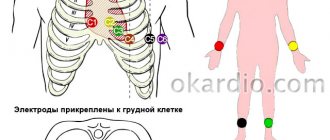Do you want to try to plan to conceive a boy or a girl? Or are you already pregnant, but can’t wait for the second screening (22-26 weeks), at which you can definitely “see” your gender?
All the main methods of planning the sex of an unborn child, as well as some methods of determining sex without ultrasound in the early stages of pregnancy are collected on this site. “The main thing is to be healthy” - most often, future parents and grandparents say this. But there are times when the birth of a child of a certain gender is important. For example, when there is a hereditary (genetic) disease in the family that is associated with gender. So, there are several most popular ways to calculate the gender of the unborn child. And also various numerological calculations, “signs” in which expectant mothers look for confirmation of their assumptions and desires.
A little physiology
Each cell of the human body has 23 pairs of chromosomes - 22 pairs of autosomes (non-sex) and 1 pair of sex chromosomes. Each pair of autosomes is identical in a man and a woman. Only the sex chromosomes differ: a woman has two X chromosomes, a man has one X chromosome and one Y chromosome. In any woman, all eggs contain one X chromosome (there are simply no other sex chromosomes in the female body). There are two types of sperm in men: those with an X chromosome and those with a Y chromosome. If the egg is fertilized by an X sperm, a girl will be born, if Y, a boy will be born. Thus, the sex of the unborn baby depends only on the man! A woman can only “contribute” in the form of an X chromosome, and the responsibility for the second necessary part lies with the dad.
Medical planning techniques
If we look at the biological facts on what the gender of a child depends, it will become clear: planning the gender is not at all easy. It is not enough to rely only on the speed and viability of sperm; in medical practice, complex and expensive methods of sex planning are used. The first technique is based on sorting sperm with male Y chromosomes and female X chromosomes. The type of chromosome is determined by special analysis. Spermatozoa, depending on their “sex,” are colored with a solution and separated by a laser. The method is called flow cytometry and has been used in artificial insemination in agriculture since around the 90s. But this method provides only an 80% guarantee, and it is not yet known what consequences may “reveal” from the effects of the laser. The second method is IVF with pre-implantation diagnosis. Before an embryo obtained “in vitro” is transplanted into a woman, several cells are separated from it and their detailed analysis is carried out - this way you can find out the sex. The use of this method is limited because not every doctor, without serious reasons, will “pluck” cells from a human embryo; In addition, this whole procedure is expensive, for some it is even prohibitively expensive. Especially when you consider that there are a number of simpler and more effective methods by which you can try to plan the sex of your unborn baby for free.
Interesting fact: in some European countries, as well as in Japan, Australia, Canada and India, medical methods of planning the gender of a child are prohibited by law - this threatens to upset the balance. They are also not welcome in countries where there are restrictions on the number of children in a family (for example, in China).
I believe - I don't believe
Whether to believe omens is a personal matter for each couple. Of course, most signs regarding the gender of the unborn baby are based on superstitions and prejudices. And some are based on nothing at all. Judge for yourself.
According to Chinese superstition, in order to have a boy, a woman needs to lie with her head to the north during intercourse, and to conceive a girl, she needs to lie with her head to the south. Among the Germanic peoples there is a superstition that if conception is “timed” in the rain, a girl will be born, and if it is in sunny weather, a boy will be born.
An interesting sign of the ancient Slavs (it can easily cause discord in the relationship between spouses): if a woman loves a man more than he loves her, a girl will be born, and if on the contrary, then a boy.
There is also such a sign: if conception occurs in the fall, then boys are born more often, and if in the spring, girls are born. This method is based on the “vitaminization” of the mother’s body - they say, in the fall there are a lot of vitamins in the body, and the boys “get started” in more comfortable conditions! And girls agree to be born in conditions of spring hypovitaminosis. However, according to science, the saturation of the female body with vitamins in no way affects the likelihood of fertilization with X- or Y-sperm. Of course, vitamins are necessary for the normal functioning of the body, especially when planning pregnancy. But so far, not a single vitamin has managed to take on the role of “determiner” of the sex of the unborn child.
Temperature technique
This floor planning technique is very common because it is quite simple to apply. Its essence lies in the fact that Y-sperm quickly die under the influence of high temperature, while carriers of the X chromosome are more resistant to the effects of heat and cold. Dads who want to have an heir should not overheat! They will have to forget about tight jeans, tight underwear, saunas, steam baths, and long periods of driving. Working in blast furnaces - no, taking a cold shower - yes!
There is some truth in this, but these precautions relate more to the possibility of having children in principle, and not specifically to a boy or girl. The fact is that under the influence of high temperature, the sperm protein denatures and all sperm lose their activity. Y-carriers die a little earlier, X-carriers die a little later, and it is impossible to calculate the period when the majority of one or the other will remain “alive.”
Dinner is served!
The method of planning the sex of a child using a special diet is a special topic. What kind of diets are not offered to expectant parents - electrolyte, French, Slavic, and Japanese...
The goal of all these diets is the same - to saturate the mother’s body with certain electrolytes (these are important biological substances involved in almost all spheres of the body’s life). All of them are equally necessary for the body, however, sperm have their own “preferences” in the saturation of specific elements. X chromosome carriers survive better in an environment saturated with calcium and magnesium, and Y chromosome carriers with sodium and potassium. And these substances are found in certain foods.
This is what the girl’s “grocery set” looks like: eggs, fresh fish, eggplants, beets, carrots, cucumbers, peas, capsicums, onions, green salad, unsalted nuts, dairy products, herbs, honey, jam. Drinks include coffee, cocoa, hot chocolate.
The boys “got” meat, bread, rice, potatoes, mushrooms, lentils, cherries, bananas, apricots, oranges, peaches, dates, dried fruits and traditionally male drinks - beer, wine, fruit juices.
This fairly common method of sex planning deservedly causes a particularly wary attitude among doctors, since, unlike other methods (calculating the date of ovulation, frequency of sexual intercourse, choosing certain positions, etc.), diet directly affects the condition of the mother’s body. An unbalanced diet (and any diet, in fact, is exactly that) threatens the exacerbation of chronic diseases, decreased immunity, hypovitaminosis, and at the same time does not at all contribute to the birth of a child of the desired sex.
"Call of blood"
One of the most popular methods for determining the sex of an unborn child is counting the “renewal” of blood. According to this technique, the state of the blood changes in a certain cyclical mode: at the beginning of the cycle, the blood is “fresher and stronger.” This determines the gender of the unborn child - whose blood is “younger”, that parent determines the gender of the unborn child.
The method, simple in its essence, is based on numerological theory. The technique of numerical patterns has reached us since ancient times; According to this theory, it is believed that all living organisms develop cyclically. At certain intervals, a programmed restructuring of the body occurs, including “renewal” of the blood. For women this interval is three years, for men - four.
The calculation is simple: the age of future parents is divided, respectively, by three for women and by four for men. Whose remainder is greater will be the floor. And an amendment: if the mother is a carrier of a negative Rh factor, then the result will be exactly the opposite.
Of course, there are no laboratory tests that can detect and evaluate the “freshness” of blood. There is also no scientifically proven pattern for the birth of children of a certain gender using this method. However, it is impossible not to note the objective value of this method - it is completely harmless to the body!
How to determine the Rh factor of a child's blood
Until recently, analysis was carried out using invasive techniques. To find out the Rh factor of the blood in the fetus, a cordocentesis procedure was performed or the amniotic fluid was examined. To do this, material was taken from the umbilical cord or amniotic fluid by penetrating the cavities . Such manipulations are associated with a certain risk; the probability of termination of pregnancy reaches up to 3%.
Therefore, invasive studies were prescribed only when a certain level of antibodies was reached. Despite its complexity, this technique did not provide the necessary accuracy of the result.
Today there is a safe and reliable alternative to invasive research methods - this is a non-invasive prenatal DNA test. It allows you without any risks for the fetus and the expectant mother and get an accurate result.
"Sprinters" and "marathon runners"
However, no matter how skeptical we may be, there are a number of observations that are statistically confirmed. These include calculating the timing of sexual intercourse relative to ovulation. Ovulation is the release of a mature egg from the ovary as a result of rupture of the follicle - the vesicle in which the egg was located. Then the egg enters the lumen of the fallopian tube, where the process of fertilization occurs - its fusion with the sperm.
Spermatozoa differ in their properties. Sperm carrying the male Y chromosome are more mobile than those carrying the X chromosome, and therefore are able to reach the egg first. So Y sperm would seem to have an advantage. But, once in the acidic environment of the vagina, Y-sperm become unstable and quickly die, opening the way for their slower X-counterparts. It turns out that sperm with an X chromosome are more viable due to the structural features of the membrane and can “sit” in the fallopian tube waiting for ovulation for up to 3 days. Spermatozoa with a Y chromosome are incapable of waiting at all.
However, the closer the day of ovulation, the more alkaline the vaginal secretions become, and the likelihood of Y sperm surviving is higher. Based on this, theories arose that claim that during sexual intercourse that occurs 1-3 days before ovulation, less durable Y-sperm die and the egg is more likely to be fertilized by an X-sperm, that is, a girl will be born.
And if sexual intercourse immediately precedes ovulation or occurs immediately after it, then, most likely, a boy will be born, since the more mobile and faster Y-sperm will quickly “reach” the released egg.
The condition for this calculation is the exact determination of the date of ovulation. There are several ways to do this: simple tests to determine ovulation, examination of cervical mucus, measurement of basal temperature, and the most reliable - folliculometry.
The method of measuring basal temperature is the most accessible, simple and quite reliable. The principle of its operation is to construct a temperature curve. To do this, you need to measure your rectal temperature every morning, without getting out of bed, and mark it, drawing a kind of graph. You should start from the first day of the cycle, which corresponds to the first day of menstruation. Approximately in the middle of the cycle, the even temperature line suddenly drops sharply - this is the day of ovulation. The next day, the line goes up just as sharply - this corresponds to the beginning of the second (luteal) phase of the menstrual cycle.
The method of studying cervical mucus is based on the fact that on the day of ovulation, the mucus is maximally saturated with estrogen and becomes abundant, stretchable, and viscous. When the mucus dries on glass, it crystallizes, and under a microscope you can see bizarre patterns - the “fern symptom”. Similar changes occur with saliva. At the pharmacy you can buy a small device to determine the approximate date of ovulation, onto which you can apply saliva and observe the appearance of the “fern”. It should be borne in mind that the fern effect appears not only on the day of ovulation, but also in the days closest to this date.
However, in modern life, the most common way to determine the day of ovulation is folliculometry - monitoring the maturation of the follicle using ultrasound. In this case, the process of follicle maturation is monitored by day, and the reliability of ovulation is confirmed by the presence of the corpus luteum - a formation that appears at the site of the burst follicle.
Popular methods for determining the sex of an unborn child
They started trying to somehow plan the gender of the child in advance a long time ago. There is a hypothesis that the founders of gender determination methods were Chinese astrologers. Now, several more methods have been added to the Chinese “tables” (some of which seem far-fetched) and many signs (which, of course, cannot work for everyone). Let’s consider the most “current” theories, information about which can be found on the Internet. The methods are deliberately listed randomly to show that absolutely everything was included in the scope of observation when planning conception in people: the age and blood of the parents, the frequency of sex, the phases of the moon, diet, ambient temperature.
By ovulation (known as the Chesterman-Phillips and Martin Young method)
The method is based on the fact that Y sperm are lighter, faster and more mobile than X sperm. But they are not so “tenacious” (less resistant to the acidic environment of the vagina and uterus). As a result, a boy is more likely to be conceived on the day of ovulation. And conceiving a girl should be done 2-3 days before ovulation (the end of the secretory phase). One day after ovulation, attempts should be stopped: according to Martin Young, this increases the risk of miscarriage and congenital deformities. The method of planning the sex of a child in this way is not entirely accurate and justified, however the percentage of “hits on the mark” is quite high. You can calculate favorable days for conceiving boys and girls using this calculator.
According to the Chinese lunar calendar
A popular method, mentions of which are often found on women's forums. The predicted accuracy is 75-80%. According to the Chinese, the sex of the baby will depend on the lunar age of the mother and the date of conception. A description of the method (with a table) and a convenient calculator can be found here.
Sex determination by blood renewal
Theory: According to this theory, which originated in Europe, a man's blood is renewed every 4 years, and a woman's blood is renewed every 3 years. To determine the sex of the unborn child, you need to divide the man’s age at the time of conception by 4, and the woman’s age by 3. Then we divide each result in half. If the man has more balance, then it will be a boy; otherwise, it's a girl. You can check who this method predicts for you by using an online calculator. Reality: In favor of the fact that the method is not truthful is the inconsistency of the data. There are options on the Internet when the results are interpreted the other way around. That is, the gender of the child is determined by which remainder will be smaller. If you already know the result of the ultrasound, then please help us collect statistics here.
Calculations based on mother's age
Calculations, as when determining gender using the Chinese table, are based on the woman’s date of birth. But instead of a table, they are enclosed in the usual formula: where X is the number of complete years of the woman, Y is the month of her birth, M is the month the child was conceived. If the result is an odd number (the remainder is discarded), then a boy will be born; if even, it’s a girl. This calculation, of course, has no basis in scientific research. But many who are interested in numerology know that calculations can be completely different. Another numerological method for determining the sex of a child is based on the Pythagorean table.
By father's age
Another method that has been transformed into a formula: according to the father’s age at the date of conception. Read more about this method on the online calculator page.
Frequency of sexual intercourse: rare - for a girl, frequent - for a boy
This is one of the “folk signs”, which confirms the previous method. According to it, the conception of a girl occurs after abstinence, and the conception of a boy occurs with frequent sexual intercourse. It is based on the fact that male sperm mature much faster. There are no statistics on the coincidence of forecast and reality.
Temperature influence
How can temperature affect the gender of the unborn baby? The fact is that low temperatures have a negative effect on male sperm (female sperm are more “tenacious” and do not suffer from the effects of cold). So when planning a boy in winter, you need to make sure that the future dad wears warm underwear and protects himself from hypothermia.
The result is guaranteed!
So are there really no reliable ways to give birth to a girl or a boy? Eat. Science does not stand still, and in medicine, high technologies are periodically introduced into general clinical practice. One such breakthrough discovery is fetal preimplantation genetic diagnosis (PGD). This technique began to be used in 1990. Now it is carried out as part of the IVF program - in vitro fertilization. This is a method of assisted reproductive technology in which conception occurs outside the mother's body. The egg is fertilized by a sperm “in vitro”, i.e. in the laboratory, and then transferred to the uterus.
PGD allows you to determine the sex and conduct genetic testing of the embryo before it is transferred into the uterine cavity and, accordingly, even before pregnancy occurs. Couples who have a high risk of transmitting a hereditary disease become “candidates” for this study.
But, despite the fact that this technique is widely used, today it does not meet the requirements of couples ordering a specific gender of the child, since it is used only to prevent the birth of children with gender-linked diseases. This extremely complex and expensive procedure is intended for genetic control of the fetus, and sex determination is only a “side effect” of this manipulation. Even the latest high reproductive technologies do not provide a 100% guarantee of results, and sometimes this procedure can cause complications. Therefore, preimplantation diagnostics of the embryo is carried out only if necessary and is not intended to satisfy idle curiosity or whims.
Perhaps the gender of the unborn child is one of the most common topics discussed during pregnancy.
From ancient times to the present day, couples have been actively looking for a way to “order the stork.” The desire to have a child of a certain gender is quite natural, unless it acquires obsessive traits and develops into a negative attitude towards a child of the “undesired” gender. To date, there is not a single reliable scientifically proven method of conceiving a fetus of a certain gender. And is it necessary? After all, the consequences could be catastrophic for all humanity. The question of the sex of the future baby is very complex - and at the same time simple. As it should be, so it will be. The birth of a child, the coming of a new person into the world is a True Miracle, and we must treat it with respect and awe. You just need to direct your efforts to planning your pregnancy with the goal of giving birth to a healthy and happy child. Boy or girl – does it really matter? Tags: cir in the media
Indications and contraindications for the procedure
There are a number of medical indications that require genetic testing.
These include:
- the likelihood of having a child with severe hereditary diseases and developmental defects;
- risk of developing Down syndrome and other genetic conditions.
Since each case is individual, you can call our center, briefly describe your situation and get answers to your questions. All consultations are provided free of charge.










